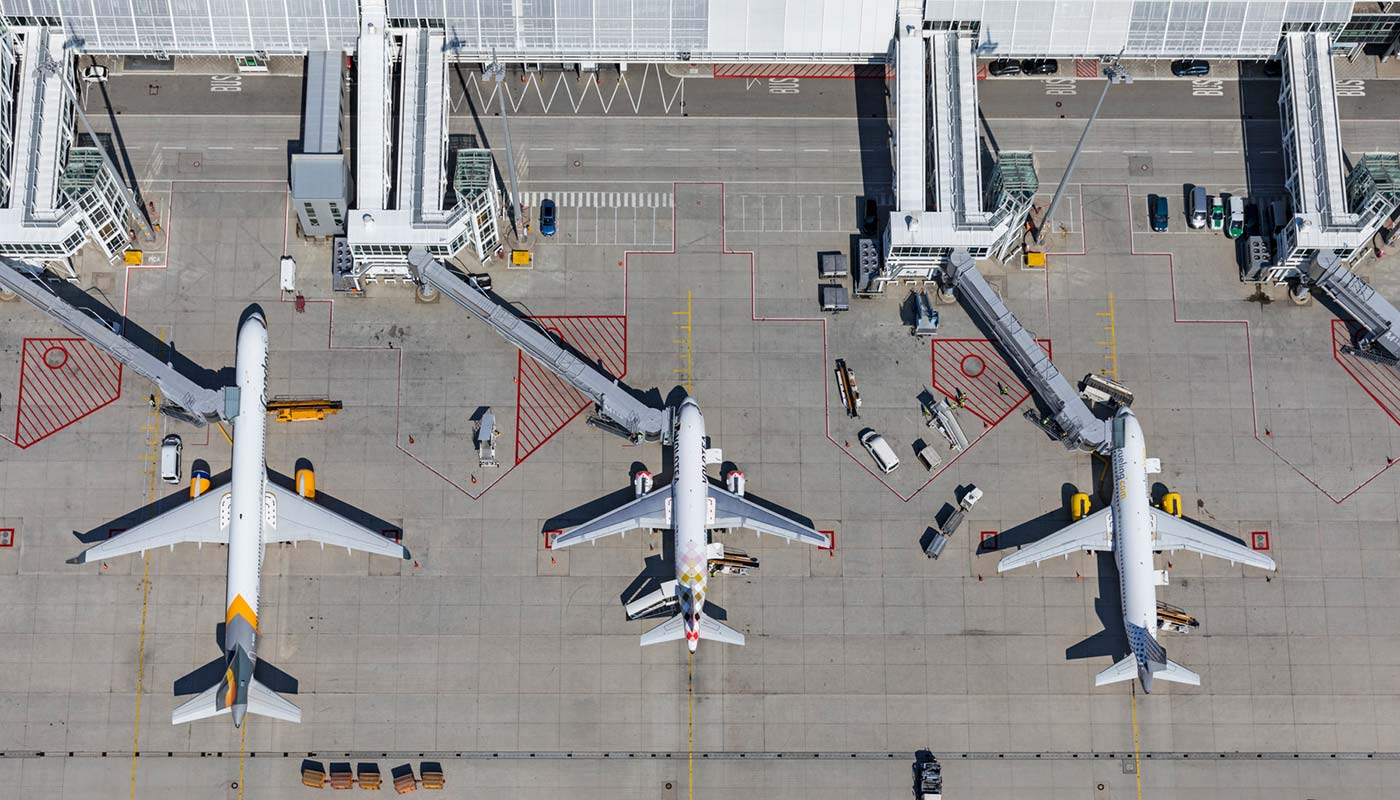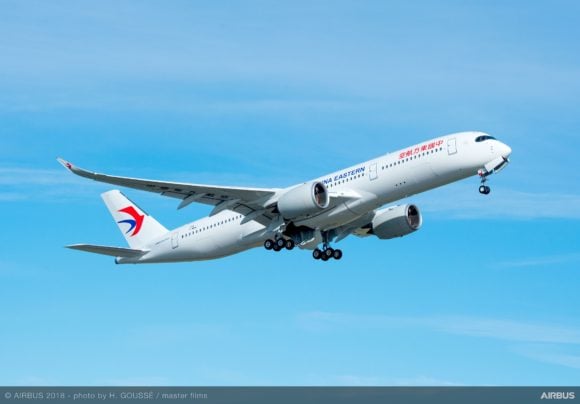
luftaufnahme vorfeld t1
UPDATE including ATAG – The International Air Transport Association (IATA) has adopted a resolution that commits the airline industry to even stricter climate targets and now aims to meet net-zero carbon emissions in 2050. During today’s 77th Annual General Meeting in Boston, IATA amended its own original targets of a fifty percent reduction in 2050 which was adopted in 2010. Meeting this target will be a huge challenge, admits Director-General Willie Walsh. IATA commits to a stricter net-zero target for 2050.
Already back in July, Walsh indicated that the original 2009 target needed revision as the problem of climate change has become more urgent since then and the general public is demanding more from aviation. “Our current path to net-zero is not ambitious enough”, he said again today at the AGM just before the voting. “For the resolution to get to net-zero emissions by 2050 we need support from governments and all other stakeholders, particularly the producers of sustainable aviation fuels (SAFs), aircraft and engine manufacturers, airports, and air navigation services providers. We must be united in order to be able to deliver on time.”
IATA calculates that in order to serve the needs of the ten billion people that are expected to fly in 2050, “at least 1.8 gigatons of carbon must be abated in that year. Moreover, the net-zero commitment implies that a cumulative total of 21.2 gigatons of carbon will be abated between now and 2050.”
Board Chairman Robin Hayes, CEO of JetBlue, added: “This commitment is the right thing to do for our industry and for humanity. Failure to adopt the resolution will lead others to set targets for us (…) through excessive and non-productive taxes.”
Getting to net-zero is a huge challenge, but realistic
The aviation industry will need a big toolbox to get to net-zero in just 29 years, IATA admits. This includes using carbon offsetting schemes like CORSIA, urgent improvements in air traffic control, drastically increasing the production of sustainable aviation fuels (SAFs) and synthetic fuels through carbon capture technology as well as developing (hybrid)electric and hydrogen technology. The transformation of the sector will require gross costs of some $2.0 trillion until 2050, Walsh estimates. “We need the support of governments, air navigation service providers, the industry, etc to get there. It is a huge challenge how to get partners each to play their role?”, said Hayes.
Getting to net-zero is a long-term effort, admits Willie Walsh: “We don’t have a clear solution in the short-term. But we do believe, and our belief has increased in recent months, that there is a credible path to net-zero by 2050. All of our activities, all of our engagements with bodies on this will be on the basis that the industry is heading for 2050.”
Despite the challenges, IATA thinks its revised target is realistic, says Walsh: “We looked at what we know is available to us today and what we think will be available going forward. We didn’t factor in complete unknowns. We did factor in the potential for hydrogen-powered aircraft beyond 2035, we did factor in SAFs effectively from today. We see in the short-term a significant ramp-up in the use of sustainable aviation fuels, we see technology going forward. We see electric and hybrid-electric being a factor but not a significant factor, because the information we have today indicates it will be only good for short-haul, commuter-type aircraft and not for the long-haul, wide-body aircraft.”
“A potential scenario is that 65 percent of this will be abated through sustainable aviation fuels. We would expect new propulsion technology, such as hydrogen, to take care of another 13 percent. And efficiency improvements will account for a further three percent. The remainder could be dealt with through carbon capture and storage (11 percent) and offsets (eighty percent). The actual split, and the trajectory to get there, will depend on what solutions are the most cost-effective at any particular time”, said Walsh. SAF production would have to increase from 7.9 billion liters in 2025 to 91 billion in 2035 and to 449 billion liters in 2050 to meet demand.
Walsh says that he has listened very carefully to what Airbus has said recently during the Airbus Summit in Toulouse, where CEO Guillaume Faury said that the hydrogen airplane Airbus is working on should be available by 2035 as planned. “Boeing takes a different view, as they that more complex and difficult. We aren’t going to argue with the manufacturers. We are saying, though, that what they are doing today isn’t enough. It isn’t enough that we get incremental change, we need a fundamental change. It is good that Airbus has committed to hydrogen and we hold Airbus to that commitment. If hydrogen can be produced in a green way it definitely is the answer.”
Chinese airlines like China Eastern pushed the IATA meeting to defer the target by ten years in line
with their government’s net-zero policy but lost out. (Airbus)
Chinese carriers wanted to move net-zero target to 2060
Although the AGM adopted the resolution, ahead of the voting, various Chinese airlines like China Southern, China Eastern, and Air China requested to amend it. They wished to move the net-zero target by ten years from 2050 to 2060, which is in line with what the Chinese government wants. During the discussions ahead of the AGM, there had been “spirited debates”, as Hayes said.
But the Chinese lost out on this request and during the press conference after the meeting, Willie Walsh explained why: “The Chinese carriers, in particular China Eastern represented by Chairman Lu, has been very consistent and very articulate with outlining the position of the Chinese government. He has at all times stressed that they are committed to achieving net-zero. The issue has always been the timeline. We debated this at significant length and there was discussion if we could facilitate the timeline of 2060 proposed by the Chinese, but the general view, particularly from those in Europe, was already we are seeing pressure to accelerate the achievement of net-zero for 2050. Moving to 2060 would not be a position that they could accept.”
While the Director-General says that no airline can ignore the targets set out in the resolution, he acknowledges that some will be in a better position than others to meet net-zero. “Each individual airline can set their own targets. We have member airlines who are aiming to achieve net-zero well before 2050. (…) We are not asking them to slow down or amend their ambitions. How individual airlines achieve it will be subject to their choices. It’s important that here, we not only commit to net-zero in 2050 but also that we demonstrate a credible pathway with options to get there. That is now the policy of IATA.”
Consumers will spur airlines on sustainability agenda
If not opting for net-zero solutions themselves, airlines will be forced by consumers to do so, said Walsh, as they have become ever-more critical, as some airlines also said during the Airbus Summit. “Are airlines going to compete on sustainability? Hell, yes”, said Robin Hayes. “This is a core part of our brand identity. If airlines are wanting to be seen as committed to the environment, they will communicate that to their customers. If that makes us better and makes us achieve this goal quicker, I think that is a very good thing.”
The resolution calls on International Civil Aviation Organization (ICAO) member states to agree on a long-term equivalent of what the airlines are willing to commit to, adding that the airline industry’s action is supported “by a coherent and coordinated policy framework which drives innovation and initiative, and doesn’t rely on cost-ineffective instruments with little or no environmental benefits such as ticket and carbon taxes.” The latter is a clear signal to the European Commission, which intends to introduce a carbon tax on kerosene in 2023.
Ahead of the voting, ICAO President Salvatore Sciacchitano encouraged the airlines to adopt the resolution. “It is imperative that we don’t waste this opportunity to get to net-zero. Commercial aviation should push for further transformation. Innovation will deliver a win-win situation.” The adoption of the resolution will help ICAO to get governments behind the same targets even more as the organization prepares for next September’s General Meeting.
ATAG also commits to net-zero
In a separate declaration released on October 5 in Boston, the Air Transport Action Group (ATAG) also says that the global air transport industry has adopted the long-term climate goal of net-zero emissions by 2050. ATAG is supported by the airlines, airports, air navigation service providers (ANSP’s), and engine and aircraft manufacturers. The declaration says that it is imperative that the industry meets the goals set out in the 2015 Paris Agreement on climate change to limit global warming to 1.5 degrees Celsius maximum by 2050.
ATAG seeks to get to the target through the same approach as outlined by IATA. The first is the increased use of SAFs, the second way is through research, development, and deployment of evolutionary and revolutionary airframe and propulsion systems (electric and hydrogen-based). The third way is via continued improvements of operations and infrastructure or airports and air traffic management. Finally, ATAG wants investments in high-quality carbon offsets in the near term and carbon removal in the long term. “As support at the global level is critical, we urge ICAO member states to support the adoption of a long-term aspirational climate goal at the 41st ICAO Assembly in 2022.”
The declaration is supported by IATA, ACI World, CANSO, IBAC, ICCAIA, Airbus, Boeing, ATR, Embraer, Pratt & Whitney, GE Aviation, CFM, Safran, Rolls-Royce, and Collins Aerospace.
The next IATA AGM is scheduled in Shanghai from June 19-21, 2022, and will be hosted by China Eastern Airlines.
Views: 1




